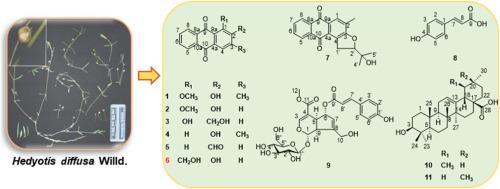白花蛇舌草地上部分的植物化学成分。一种新的蒽醌和化学分类学见解
IF 2
4区 生物学
Q4 BIOCHEMISTRY & MOLECULAR BIOLOGY
引用次数: 0
摘要
通过乙醇提取、溶剂分配和色谱技术,从白花蛇耳草(Hedyotis diffusa)的地上部分分离到1个新的蒽醌(6)和10个已知的次生代谢产物(1 - 5,7 - 11)。利用ESI-MS、一维和二维核磁共振光谱分析对分离化合物的结构进行了鉴定,并与已发表的光谱数据进行了比较。这些化合物分别鉴定为洋地黄苷(1)、2-羟基-1-甲氧基蒽醌(2)、二花麦草醇(3)、2-羟基-3-甲氧基蒽醌(4)、9,10-二氧基-9,10-二氢蒽醌-2-乙醛(5)、2-羟基-1-羟基甲氧基蒽醌(6)、capitellataquinone D(7)、对香豆酸(8)、e- 6- o-对香豆油苷甲酯(9)、熊果酸(10)和齐墩果酸(11)。化合物6为新化合物,化合物7为首次从白花花中分离得到。蒽醌6和蒽醌7的鉴定表明它们可能作为化学分类指标。本文章由计算机程序翻译,如有差异,请以英文原文为准。

Phytochemical constituents from the aerial parts of Hedyotis diffusa Willd.: A novel anthraquinone and chemotaxonomic insights
A new anthraquinone (6) and ten known secondary metabolites (1–5, 7–11) were isolated from the aerial parts of Hedyotis diffusa through ethanol extraction, solvent partitioning, and chromatographic techniques. The structures of isolated compounds were elucidated using ESI-MS, spectroscopic analyses of 1D and 2D-NMR spectroscopy, and compared with published spectral data. These compounds were identified as digitolutein (1), 2-hydroxy-1-methoxyanthraquinone (2), digiferruginol (3), 2-hydroxy-3-methylanthraquinone (4), 9,10-dioxo-9,10-dihydroanthracene-2-carbaldehyde (5), 2-hydroxy-1-hydroxymethylanthraquinone (6), capitellataquinone D (7), p-coumaric acid (8), E-6-O-p-coumaroyl scandoside methyl ester (9), ursolic acid (10), and oleanolic acid (11). Compound 6 is new, while compound 7 was obtained from H. diffusa for the first time. The identification of anthraquinones 6 and 7 suggests their potential role as chemotaxonomic indicators.
求助全文
通过发布文献求助,成功后即可免费获取论文全文。
去求助
来源期刊

Biochemical Systematics and Ecology
生物-进化生物学
CiteScore
3.00
自引率
12.50%
发文量
147
审稿时长
43 days
期刊介绍:
Biochemical Systematics and Ecology is devoted to the publication of original papers and reviews, both submitted and invited, in two subject areas: I) the application of biochemistry to problems relating to systematic biology of organisms (biochemical systematics); II) the role of biochemistry in interactions between organisms or between an organism and its environment (biochemical ecology).
In the Biochemical Systematics subject area, comparative studies of the distribution of (secondary) metabolites within a wider taxon (e.g. genus or family) are welcome. Comparative studies, encompassing multiple accessions of each of the taxa within their distribution are particularly encouraged. Welcome are also studies combining classical chemosystematic studies (such as comparative HPLC-MS or GC-MS investigations) with (macro-) molecular phylogenetic studies. Studies that involve the comparative use of compounds to help differentiate among species such as adulterants or substitutes that illustrate the applied use of chemosystematics are welcome. In contrast, studies solely employing macromolecular phylogenetic techniques (gene sequences, RAPD studies etc.) will be considered out of scope. Discouraged are manuscripts that report known or new compounds from a single source taxon without addressing a systematic hypothesis. Also considered out of scope are studies using outdated and hard to reproduce macromolecular techniques such as RAPDs in combination with standard chemosystematic techniques such as GC-FID and GC-MS.
 求助内容:
求助内容: 应助结果提醒方式:
应助结果提醒方式:


